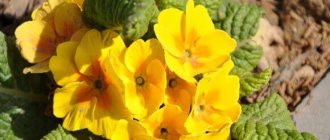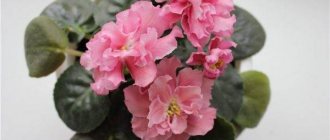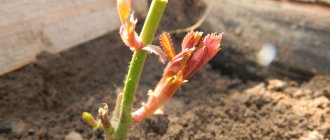Description
First, let's give a description of the Green Rose violet.
Its leaves are large and slightly wavy at the edges. The predominant color is beautiful, rich dark green. Growth proceeds from the center to the edges, resulting in the formation of a strong rosette.
You may be interested in: Indoor Hippeastrum flower: care at home
But, of course, the main feature of the variety is its gorgeous flowers. They consist of numerous petals with wavy edges, arranged in the same way as in rose flowers - hence the name. At the edges the petals are pale yellow or even light green. There are also exquisite inclusions – strokes of lilac color. During one flowering, 6-7 flowers are usually formed. Moreover, with a new flowering, the shade and structure of the flowers can differ significantly - this makes the growing process especially interesting. Colors can also be affected by ambient temperature. If the temperature drops below +20 degrees Celsius, then light colors predominate - yellow and light green. But if the room is hot - above +26 degrees - then a large number of purple and even crimson inclusions appear on the petals. Of course, when choosing a sprout, any florist expects that it will retain the characteristics of the parent plant. However, this is not always observed in violets. Quite often, a young plant has flowers of a different color, very different from the flowers of its parents. Such specimens are usually called “sport”. Violet Green Rose is no exception. Therefore, you should be prepared for this.
Varieties of green Saintpaulias
Some varieties of violets cannot be called anything other than “miracle”. Green varieties are the result of many years of experience and enormous work. By crossing blue and yellow violets, we managed to get green Saintpaulias, which are striking in their originality - a symbol of harmony and stability.
- Green Apollo . Bred by E. Lebetskaya, semi-double snow-white flowers are bordered with a bright light green fringe. Pinkish stamens modestly peek out from the center of the flower, shaded by soft pink spots on the petals.
- Pearly Buttons Saintpaulia. The variety is distinguished by its light green outer petals and lush double spherical flowers. E. Korshunova managed to develop this variety.
- Green Dragon . A miniature hybrid with a whole cap of white-green flowers above dark green variegated leaves.
- Green Lagoon. The creation of the breeder Sorano surprises with its double stars of pastel colors, bordered by a fringe of golden-greenish hue.
- Green rose. Very elegant snow-white-pink flowers with a ruffled green border are surrounded by wavy foliage.
Green Saintpaulia apples
Suitable soil and pot
You may be interested in: Watering cyclamen at home: rules for caring for an indoor flower
Before you start breeding violets, you need to take care of suitable growing conditions. There are several subtleties here that are very important to know about.
First of all, the pot. It would seem that everything is simple here - any container with drainage holes in the lower part will do, so that excess moisture can be freely removed without leading to rotting of the root system. However, the size of the plant should be taken into account here. It is not worth planting a tiny violet in a large pot. Otherwise, the plant will devote all its efforts to developing the root system. This will take many months and all this time the violet will not bloom - hardly anyone will be happy with this situation. Therefore, it is advisable to plant a small leaf with roots in a small pot. Then the root system will quickly occupy the entire available volume and the plant will finally begin to bloom. Over time, the grown plant will need to be replanted - we’ll talk about this a little later.
You may be interested in: How to plant Decembrist plants at home: rules and tips
The choice of soil also needs to be taken very seriously. It is advisable to use fertile soil - black soil or any other soil mixed with compost - an excellent fertilizer. If the soil is too dense, then it would be a good idea to slightly dilute it with sand to facilitate the passage of moisture and oxygen to the roots.
Of course, it is advisable to pour a little crushed stone or pebbles at the bottom of the pot, and only then pour soil on top of them - then the plant will develop most quickly.
Description and varieties of mini Saintpaulias (miniature violets)
Fragile and defenseless in appearance, miniature violets have an unbending will to live and develop. All varieties of this type are internally divided into miniature (rosette up to 15 cm), semi-miniature (up to 20 cm in diameter) and microminiature (6 cm).
These tiny indoor plants will respond to attention and care, thanking the owner with luxurious inflorescences of various shades depending on the variety. Thus, Festive Fantasy will be decorated with bright purple flowers, and Mac's White Water will be decorated with white and burgundy flowers. Some of the most popular varieties: Lollipop, Heaven's Smile, Golden Dawn, Cirelda, Boo Men, Bellita, etc. More detailed information about each variety can be found in specialized botanical literature.
Also read: Garden tradescantia: characteristics of the best varieties and growing rules
Saintpaulia Festive Fantasy
Correct conditions
In order for the violet of the Green Rose variety to actively grow and develop, it is necessary to provide it with certain conditions. First of all, these are humidity, temperature and lighting. Let's look at each of the parameters in more detail.
Like most violets, this variety prefers high air humidity - 50% or more. However, at home, this indicator is quite difficult to maintain - especially in winter, when radiators and heating devices dry out the air. Therefore, it would be a good idea to use a special humidifier or simply spray the plants with a spray bottle once or twice a day.
In general, violets are not too demanding on temperature conditions, successfully developing in a fairly wide range. But still, they grow best at temperatures from +18 to +30 degrees Celsius. As mentioned above, the appearance of flowers depends on this indicator.
Any plant needs a sufficient amount of light so that the process of photosynthesis actively occurs in the leaves. In summer there are usually no problems - there is enough lighting. True, you need to make sure that the violet does not get burned from direct sunlight - it is better to place the pot not on the south side. Otherwise, overheating will cause the leaves and flowers to wither and then dry out. But in winter there is clearly not enough light. Therefore, in order for the plant to develop successfully, it is necessary to provide them with a sufficient amount of artificial lighting. Fortunately, coping with the task is not at all difficult - just install a fluorescent lamp on the window.
Violet Flower
Violet is a houseplant from the herbaceous family. The birthplace of this culture is Tanzania. The plant was discovered and described by Baron Walter von Saint-Paul at the end of the 19th century. Growing these flowers is very simple, and even a novice gardener will not encounter any serious difficulties. This article describes the best violets and the features of their cultivation.
Indoor violet
Indoor violets are small and grow in a compact, beautiful bush. The stem is short. The leaves are green, oval, emerging from a rosette. They are located on long petioles and covered with small fibers. The leaf can be up to 8 cm in length!
Photo of violet “Wedding bouquet”
Interesting!
Violets are a sign of prosperity and rebirth. Depending on the color of the flowers, they have their own special energy. Thus, a white violet is a symbol of purity, blue is a symbol of love, blue is a symbol of creativity, purple is a symbol of spirituality, and red is a symbol of optimism.
Photo of violet "Lyubasha"
the plant will develop. It is very important to be able to choose the right pot for young violets. Flowers are capricious in this matter! This crop has a small root and does not require much soil. The violet should be about 3 times larger than its pot. Based on this, you can choose a good pot.
Interesting!
You cannot choose a pot for growing violets! Flowering in this crop is observed only after the roots have entwined the entire container in which they are located!
It is better to purchase soil in a store - especially for violets. But if you don’t want to spend money on soil, you can make it yourself. To do this, mix garden soil and a little sand. After this, the resulting mixture must be calcined or treated with potassium permanganate to destroy harmful microorganisms. A third of the way, the pot is filled with drainage, and an earthen substrate is poured on top.
Planting is carried out carefully so as not to damage the fragile roots. At the same time, the cuttings cannot be deeply buried, otherwise young leaves will not appear soon.
Flower care at home
Indoor violets are easy to care for, but so that they do not get sick and grow normally, they are provided with normal conditions.
Photo of violet “Beautiful Creole”
- Violets love light very much. Good lighting should be available for 14 hours. In this case, it is necessary to darken these flowers from the bright sun so that burns do not appear on the leaves.
- The temperature in the room where violets are grown should be within +18...+25 in summer, and +10...+15 degrees in winter. These flowers do not like the cold. In winter, they should not be kept on cold windowsills. From the cold, the roots and leaves of plants can begin to rot or wither. For this reason, in winter they must be placed on wooden stands and moved away from the windows.
- Humidity should not be low. If the air in the house is dry, you need to place flowers in trays with wet expanded clay or place a humidifier nearby.
Interesting!
Different types of violets require the same growing conditions. Many lovers keep entire collections of a wide variety of varieties in their homes.
- How to water? Violet does not like waterlogging or dry soil. It should be watered as needed when the top layer of soil begins to dry out. In summer, 2 waterings per week are usually sufficient, and in winter – 1 time per week. Water for irrigation is taken settled, rain or filtered. You need to water so that the water does not get on the growth buds. Because of this, these flowers are usually watered using the drip method or a watering can with a thin spout.
Important!
Spraying is harmful to violets. Drops accumulate on the leaves and do not evaporate, causing rot to develop.
Photo of violet "Duchess"
- Fertilizing is necessary only in the spring, when the buds are forming. In summer, autumn or winter there is no need for fertilizing. For this you can buy special drugs. Nitrogen fertilizers provoke the development of green mass, and potassium-phosphorus fertilizers promote lush flowering.
- Transplantation is usually carried out in the spring. This is the most favorable time. In winter it is too cold, in summer it is too hot, and in autumn the growing season ends and the plant simply cannot take root normally. Replanting is necessary after purchasing a new flower, when diseases, pests, soil depletion appear, as well as for rooted cuttings.
Problems when growing violets
Difficulties in growing violets arise in rare cases. They are usually associated with improper care.
- Why don't violets bloom? Indoor violets under normal conditions grow well and bloom regularly. But it also happens that the plant stops blooming. What to do in this case? You need to pay attention to the pot. If it is very large, then the violet simply will not be able to bloom until it grows - the plant gives flowers after the roots have entwined the entire earthen lump in the pot!
- Why do the leaves turn yellow? Violet leaves usually turn yellow when the soil is depleted. In this case, either fertilizing or transplanting to new soil can help. Photo of the “Green Lagoon” violet
- What to do if the leaves become pale? Pale leaves indicate a lack of light. At the same time, the bush stretches upward (toward the light). Lack of light usually leads to the fact that the crop gradually fades. For the problem to disappear, it is necessary to provide the violet with better lighting.
Interesting!
Violets do not emit allergens, so they can be grown even by people prone to allergies.
Diseases and pests of violets
Indoor violets rarely get sick, but this also happens with insufficient attention to the culture. Among the infections and fungi that are dangerous for this plant are: powdery mildew, gray rot, and fusarium. In addition, the violet can be affected by nematodes, aphids, mites or thrips.
When diseases appear, it is necessary to use special preparations (Fundazol, Skor) for spraying. As a preventative measure, the fungicide “Fitosporin” is used. And in the event of pests appearing on the plant, treatment is carried out with insecticides such as Fitoverm, Regent, Mospilan.
Source: https://fermerok.info/tsvetok-fialka
Germination and planting
Now let's talk about the propagation of Green Rose violets. Flowers are quite easy to germinate. If you see a beautiful plant from your friends, you can simply ask them to separate a single leaf from it. Of course, it is advisable to choose an even, beautiful and large leaf, and not from the edge, but directly from the center - they receive the most nutrients, which is why they are the most viable. After that, half the work is already done!
All that remains is to place the leaf in a small container of water. Make sure that the lower end (cut) is always in water and never dries out - this will lead to the death of the plant. But at the same time, only the cutting itself should come into contact with water, and not the leaf - otherwise excess moisture will have a bad effect on it, and even rot may appear.
After a few days, small roots will appear at the bottom of the leaf. So it’s time to plant the plant in the ground. What soil and pot to choose is described above. All that remains is to moisten the soil well, dig a small hole in it, place a leaf there so that all the roots are in the hole, and carefully cover it with soil on top, lightly compacting it for density. That's all! Now the plant will probably actively grow and develop.
Types of Saintpaulia by leaf shape and color
The last, but no less significant criterion for dividing violets into varieties is their foliage, which varies from variety to variety in shape and color.
The shape can be the most bizarre: from round (Pearly Buttons), oval (Lollipop Kid) and heart-shaped (Optimara Little Shoshone) to pointed, oak and even spoon-shaped (Nymph Fly). In this case, the edges of the leaves can resemble waves (Haritage Floric), fringe or cloves (Rob's Cotton Ball). Based on the nature of the connection between the leaf itself and the petiole, all species are divided into “boys” and “girls” . The main difference is that in male leaves, their main part is clearly separated from the stem and is visually more distinguishable. In “girls”, instead of a clear transition, there is a light spot from which thin veins run along the surface of the entire leaf. In natural conditions, boy-sheets are most often found.
Also read: Using Iberis in garden design
Pearly Buttons Saintpaulia
Among all the Saintpaulia varieties, the variegated varieties (Midas Moon Beam, Jolly Jubilee, Skies Over Italy, Mikinda Girl) . Very often this characteristic turns out to be unstable and can only appear for a while. This should be considered a reaction to improper growing conditions.
As for the color of the leaves, breeders divide all species into dark green, medium green and light green. The color of the foliage depends on two factors: firstly, on the growing conditions (i.e. shades can vary even within the same variety), and secondly, on the tone of the inflorescences (the darker the flowers, the darker the foliage, and vice versa) . For some hybrids, not only the top side of the leaf is important, but also the bottom. Examples of varieties with different shades of foliage:
- Dark green color – Little Pushover
- Medium green color – Pink Playmate
- Light greens – Optimal Little Cheyenne
- Lime Back – Rob's Cotton Ball
- Raspberry-burgundy reverse – Rob's Calypso Beat, Lace Shadows
A little about watering
Violets should be watered as the soil dries. Accordingly, this will have to be done more often in the summer, and less often in the winter. In addition, the soil dries out faster in small pots than in large ones.
Watering should be done only with settled water - not cold from the tap. It is advisable to pour water into a suitable container - a glass, jar or any other with a wide neck (to facilitate the process of chlorine evaporation) and leave for a day. During this time, it will warm up to room temperature and get rid of dangerous chlorine. Too hot or cold water may well lead to diseases and damage to the roots.
When watering, try to pour water directly onto the ground. If it gets on the leaves on a hot sunny day, burns are possible - white spots will appear on their surface.
Catalog of popular Saintpaulia varieties with names
Some violets are especially loved by flower growers. Below are descriptions of the most popular varieties today.
Saintpaulia Rosemary
Bred by E. Lebetskaya; The name is translated from Latin as “fog on the sea.” Extraordinarily beautiful large double flowers almost always decorate this plant. The characteristic fantasy coloring and various combinations of lilac, blue, pink, blue and white make this hybrid truly unique.
Saintpaulia Rosemary
Saintpaulia K. Moreva Azalia
Stunningly beautiful double star flowers, whose color varies from bright crimson to deep burgundy, make an indelible impression against the background of dark pubescent foliage.
Saintpaulia K. Moreva Azalia
Allegro Appalachian
Refers to standard trailer varieties. A very delicate plant with lilac pansy-shaped flowers, decorated with dark fantasy touches. The leaves are light green and pointed.
Saintpaulia Allegro Appalachian
Queen of the ball
A variety from the collection of bred hybrids by E. Korshunova. It is distinguished by large double flowers. The colors are usually bright, in shades of pink, sometimes with a lilac border.
Saintpaulia Prom Queen
Emergency
Will add to your home collection with its semi-double bright flowers with a white velvety border and scarlet petals. It is distinguished by spoon-shaped leaves with a reddish underside and long petioles.
Saintpaulia Emergency
Curly Sue
An unusually elegant and delicate plant: the inflorescences are a cap of pinkish double airy flowers. This variety blooms for a very long time.
Saintpaulia Curly Sue
Fairy
The owner of this variety will be lucky to see lush inflorescences of double pinkish flowers, decorated with a lilac fringed border. The leaves are glossy, dark green in color.
Saintpaulia Fairy
Ocean
Expanded name - EK - Gray Ocean. Above a small neat rosette rise huge (up to seven centimeters) clusters of spherical double flowers of a bluish-white or violet-white hue.
Saintpaulia Ocean
Dark night
A variety bred from the sport of Running on the Waves. It stands out among its fellows for its deep purple or dark blue flowers formed by fringed petals.
Saintpaulia Dark Night
Bold Party Girl
Against the background of medium green foliage, the early blooming heavy corollas of double stars of fantasy color with a ruffled border stand out. Color combinations can be very diverse. Blue, blue, lilac-pink, lilac and white shades make this variety one of the most difficult to distinguish.
Fire House
The plant is recognizable by its double dark red stars with a thin white border and a neat small rosette with dark, even leaves.
Saintpaulias are still subject to selection and increase their varietal wealth. Thanks to this variety of colors, everyone who wants to have a modest beauty in their home has the opportunity to discover not only existing varieties, but also get new ones!
Transplantation
It was already mentioned above that violets need to be replanted regularly. Up to one year it can easily grow in a small pot. But then you should transplant it into a larger pot and repeat the procedure every two years.
Old plants especially cause a lot of trouble. It is not enough to simply replant them - you need to carefully remove the outer leaves directly from the rhizome, leaving only the middle. This rejuvenation of plants leads to active growth.
With young violets everything is much simpler. You need to prepare a pot into which you plan to transplant the plant, pour soil into it and make a large depression in it. The soil in the pot with the violet needs to be slightly moistened, and then carefully turned over, trying to shake it out along with the plant - here it is very important not to damage the root system, otherwise the violet will hurt and may even die. All that remains is to place the soil in the prepared hole and water it well.
Don't forget about fertilizers
For the first six months after planting in fresh soil, there is no need to fertilize the violet - the soil contains all the necessary substances. Then you need to feed the flower every two weeks - this is especially important during the flowering period.
An actively growing plant needs to be fertilized with nitrogen fertilizers - they ensure rapid growth of green mass (stems, leaves). Immediately after transplanting, you can add a little phosphorus, which is needed for the rapid development of the root system. But before flowering, you need to fertilize the violet with potassium fertilizers - then there will be more buds and their size will also increase.
Of course, when fertilizing, carefully study the instructions so as not to harm the plant due to excess microelements.
Possible difficulties during cultivation
Most often, violet lovers encounter aphids and mites. The appearance of aphids can be noticed by the gradually curling leaves. The problem is solved after treating the leaves with a special powder preparation - Mospilan.
Mites most often appear on old, drying leaves. Therefore, if you spend at least a few minutes a couple of times a week removing dry leaves, you will probably not encounter this problem.











